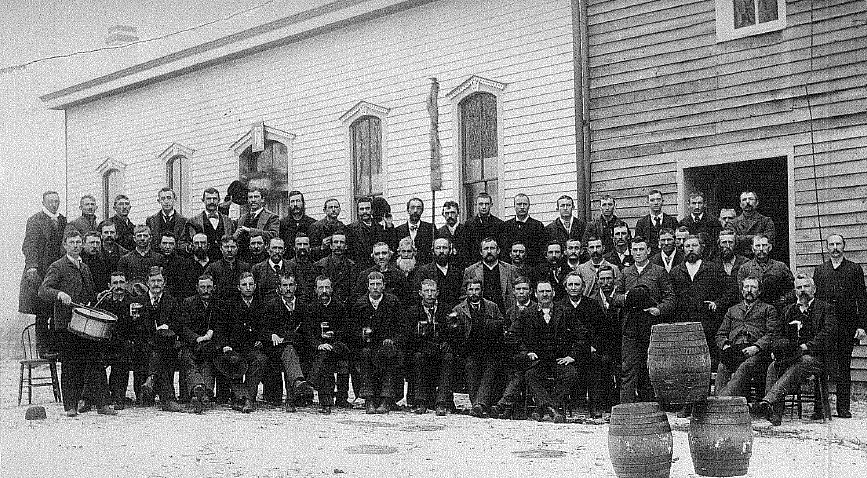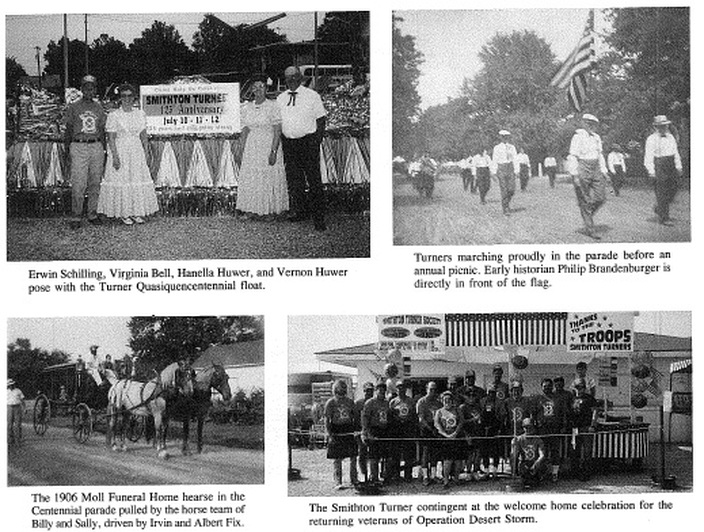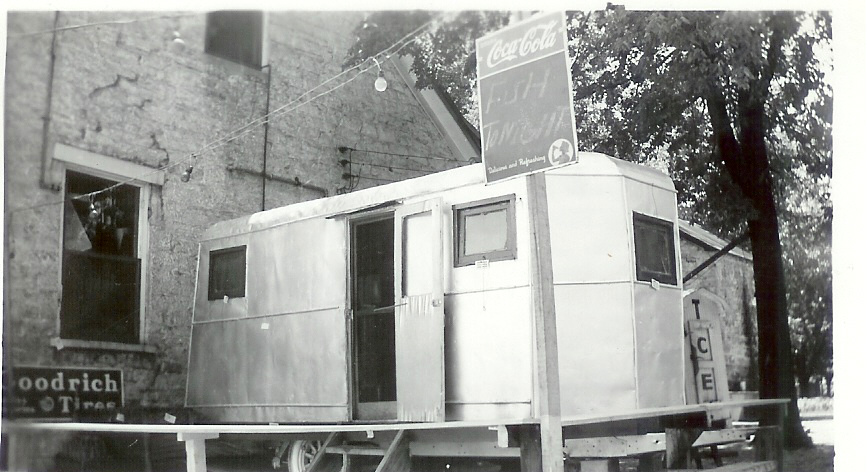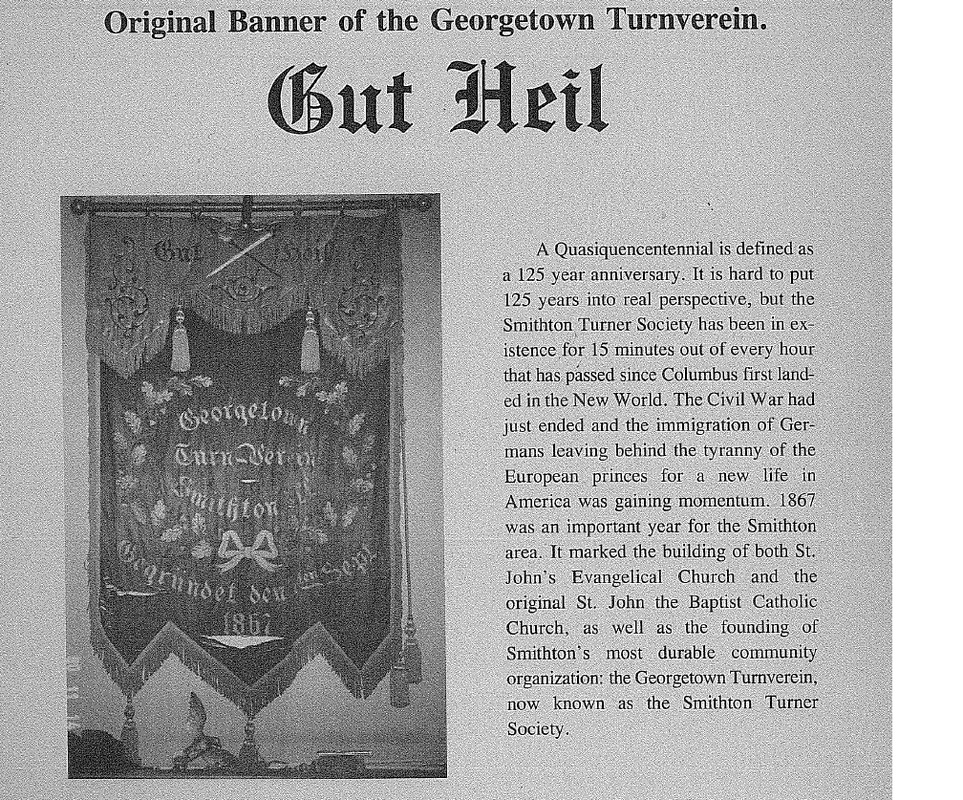Smithton Turner Society
The Smithton Turner Society was organized as the Georgetown Turnverein by 31 men of Smithton and vicinity on September 5, 1867, to promote health,
gymnastics, and fraternal activities for its members. All business of the new organization was recorded exclusively in the German language. Several of the
names on the current organizations membership list are descendants of some of the charter members. The last living charter member, Fred Pfeiffer, died
January 24, 1919. The first officers were: Edward Berghaus, Erster Sprecher; Charles Moxter, Zweiter Sprecher; Theodore Muensch, Erster Turnwart;
Nicholas Daesch, Erster Schriftwart; Jacob Thress, Zweiter Schriftwart; Jacob Ohlendorf, Kassenwart; Louis Forcade, Zeugwart. By January of 1870 membership
dwindled down to twelve members consisting of the following: George Daab, John Daab, George Forcade, John Reidel, John Ohlendorf, Nick Daesch,
Fred Pfeiffer, Charles Maedel, William Rohlfing, Jacob Gross, Edward Berghaus, Charles Maxtor. The patience and persistence of these dozen faithful members
held the Turners together, and by the end of that year the membership was back up to 34, and the future of a strong and vibrant organization was firmly grounded.
Up to 1882, officers we re-elected every six months at the March and September meetings. Any member absent from an election was subject to a fine of 25 cents.
These imposed fines as well as fines for not visiting the sick and waiting on them at night were strictly enforced. In 1877, the 'president appointed three trustees to
take charge of the affairs of the society, and from 1890 they were voted on in the elections held at the Annual Meeting. The Society incorporated in the State of
Illinois in 1889. The Constitution and Bylaws of the Georgetown Turnverein were revised and adopted March 31, 1906, and translated into English and revised
January, 1920. Further revisions are dated: January, 1939; January,1947; January 7, 1962; January 6, 1974; January 19, 1979; January 12,1986; January 10, 1988.
At the Annual Meeting on January 14, 1990, the Turners adopted a completely re-written Constitution and By-laws that eliminated some of the Society's anachronistic features while still building on the traditions and ideals that have positioned the organization to step with pride into the 21st Century.
The stated purpose of the Turnverein was to keep the body physically fit and the mind alert. Many of the area's German settlers were proud of their strength and agility in turning and tumbling, so they organized clubs for themselves to facilitate the practice. In the early years Turner meetings were held in the Cooper shop on Hickory Street. The Cooper shop was located next to the flour mill, and the barrels were used to transport flour pulled by a team of oxen over the old Plank Road to Belleville. The turn bars and equipment was stored in a barn across the street, and the swings were set up in a lot nearby at Hickory and Cass Streets. The first year's expenses included two dozen white shirts and suits, and one and one-half dozen belts and caps which they sported on suitable occasions. The first Masked Ball was held on February 18, 1868 at Keim's Hall adjoining Franklin Tavern (now part of the Smithton Lumber Company and probably the oldest building standing in town). The band furnishing the music received $14 and meals. The admission was 50 cents for men and 125 tickets were sold. When the weather was good, a mask ball parade would take place in the afternoon led by the band. Before 1879 the mask ball was held in various places around town.
gymnastics, and fraternal activities for its members. All business of the new organization was recorded exclusively in the German language. Several of the
names on the current organizations membership list are descendants of some of the charter members. The last living charter member, Fred Pfeiffer, died
January 24, 1919. The first officers were: Edward Berghaus, Erster Sprecher; Charles Moxter, Zweiter Sprecher; Theodore Muensch, Erster Turnwart;
Nicholas Daesch, Erster Schriftwart; Jacob Thress, Zweiter Schriftwart; Jacob Ohlendorf, Kassenwart; Louis Forcade, Zeugwart. By January of 1870 membership
dwindled down to twelve members consisting of the following: George Daab, John Daab, George Forcade, John Reidel, John Ohlendorf, Nick Daesch,
Fred Pfeiffer, Charles Maedel, William Rohlfing, Jacob Gross, Edward Berghaus, Charles Maxtor. The patience and persistence of these dozen faithful members
held the Turners together, and by the end of that year the membership was back up to 34, and the future of a strong and vibrant organization was firmly grounded.
Up to 1882, officers we re-elected every six months at the March and September meetings. Any member absent from an election was subject to a fine of 25 cents.
These imposed fines as well as fines for not visiting the sick and waiting on them at night were strictly enforced. In 1877, the 'president appointed three trustees to
take charge of the affairs of the society, and from 1890 they were voted on in the elections held at the Annual Meeting. The Society incorporated in the State of
Illinois in 1889. The Constitution and Bylaws of the Georgetown Turnverein were revised and adopted March 31, 1906, and translated into English and revised
January, 1920. Further revisions are dated: January, 1939; January,1947; January 7, 1962; January 6, 1974; January 19, 1979; January 12,1986; January 10, 1988.
At the Annual Meeting on January 14, 1990, the Turners adopted a completely re-written Constitution and By-laws that eliminated some of the Society's anachronistic features while still building on the traditions and ideals that have positioned the organization to step with pride into the 21st Century.
The stated purpose of the Turnverein was to keep the body physically fit and the mind alert. Many of the area's German settlers were proud of their strength and agility in turning and tumbling, so they organized clubs for themselves to facilitate the practice. In the early years Turner meetings were held in the Cooper shop on Hickory Street. The Cooper shop was located next to the flour mill, and the barrels were used to transport flour pulled by a team of oxen over the old Plank Road to Belleville. The turn bars and equipment was stored in a barn across the street, and the swings were set up in a lot nearby at Hickory and Cass Streets. The first year's expenses included two dozen white shirts and suits, and one and one-half dozen belts and caps which they sported on suitable occasions. The first Masked Ball was held on February 18, 1868 at Keim's Hall adjoining Franklin Tavern (now part of the Smithton Lumber Company and probably the oldest building standing in town). The band furnishing the music received $14 and meals. The admission was 50 cents for men and 125 tickets were sold. When the weather was good, a mask ball parade would take place in the afternoon led by the band. Before 1879 the mask ball was held in various places around town.
The Turner Hall and the Park
The Turner Hall stands on the corner of Fischer and Julia Streets on the site of the old Georgetown Brewery. John Schmitt sold the brewery to Heinrich Keim in 1865 for
$8500. Frank Benedick and John Bechtoldt bought it later, then Phillip Grandcolas and Frank Benedick sold it to the Turners in 1879 when it was turned into a hall. Besides use as a brewery, the building also had served as a Catholic school and as the residence of a number of families. The first dance given at the present location of the hall was in 1880. After additions increased the capacity of the hall, the Verein so prospered that in the early 1890's the old building was torn down and a two-story one was erected in its stead. Additions, including a stage and improvements on the building and facilities, through the years have produced the current state of the Smithton Turner Hall, still known far and wide for the quality of its dance floor and as one of the finest and best equipped dance halls and reception centers in the county.
Together, the Turner Hall and Park have provided the facilities for much of the social life of the Smithton community. The band stand was originally a circular floor urrounded by a railing, and in 1904 it was remodeled by raising it high enough to accommodate a full bar beneath it in an eight-sided pavilion in the park. This was a two story structure with the band stand in the top floor reached by a detachable stairway. The music of the bands had great carrying power, due to its being produced at a distance from the ground. This fabulous bandstand was the centerpiece of the picnic celebrations for many years, but it eventually deteriorated and was torn down
and removed to make room for the present raffle stand.
In the early 20's the Smithton Amusement Company held fortnightly picture shows on Sunday nights at the Turner Hall. The Turners bought the picture machine on January 1, 1926 and showed motion pictures for a time. The early park and hall were lighted by a gasoline torch consisting of a circular 12' tank and a gas jet joined by a two foot length of pipe with the jet at the bottom and the assembly hung in many places on trees in the park and on walls and posts in the hall. The visitors horses were kept in the wagon yard stable at Herolds Tavern (the American Legion hall) with rooms available Saturday night in advance of the Sunday picnics. Lighting for the
hall and park advanced from the gasoline torch to a Fairbanks Morse system and Alanco lights driven by motors, to the modern electrical system first installed in 1930,
and continually upgraded and improved to the present. A state of the art Heil sound system for both the hall and the park was installed in the early 1990's , resulting in a totally agreeable setting for community picnics and gatherings.
Smithton community organizations still make regular use of the Turner Hall and Park, with some of the uses being the Boy Scout Blue & Gold banquet, grade school
pageants and graduations, summer picnics, benefit dances, programs, and classes. The hall and park are also rented for private gatherings such as weddings and anniversary parties. The world famous Smithton Turner Fish Fryers can also be seen in action and their wares sampled at other selected events such Smithton Homecoming, and every Friday night during lent.
$8500. Frank Benedick and John Bechtoldt bought it later, then Phillip Grandcolas and Frank Benedick sold it to the Turners in 1879 when it was turned into a hall. Besides use as a brewery, the building also had served as a Catholic school and as the residence of a number of families. The first dance given at the present location of the hall was in 1880. After additions increased the capacity of the hall, the Verein so prospered that in the early 1890's the old building was torn down and a two-story one was erected in its stead. Additions, including a stage and improvements on the building and facilities, through the years have produced the current state of the Smithton Turner Hall, still known far and wide for the quality of its dance floor and as one of the finest and best equipped dance halls and reception centers in the county.
Together, the Turner Hall and Park have provided the facilities for much of the social life of the Smithton community. The band stand was originally a circular floor urrounded by a railing, and in 1904 it was remodeled by raising it high enough to accommodate a full bar beneath it in an eight-sided pavilion in the park. This was a two story structure with the band stand in the top floor reached by a detachable stairway. The music of the bands had great carrying power, due to its being produced at a distance from the ground. This fabulous bandstand was the centerpiece of the picnic celebrations for many years, but it eventually deteriorated and was torn down
and removed to make room for the present raffle stand.
In the early 20's the Smithton Amusement Company held fortnightly picture shows on Sunday nights at the Turner Hall. The Turners bought the picture machine on January 1, 1926 and showed motion pictures for a time. The early park and hall were lighted by a gasoline torch consisting of a circular 12' tank and a gas jet joined by a two foot length of pipe with the jet at the bottom and the assembly hung in many places on trees in the park and on walls and posts in the hall. The visitors horses were kept in the wagon yard stable at Herolds Tavern (the American Legion hall) with rooms available Saturday night in advance of the Sunday picnics. Lighting for the
hall and park advanced from the gasoline torch to a Fairbanks Morse system and Alanco lights driven by motors, to the modern electrical system first installed in 1930,
and continually upgraded and improved to the present. A state of the art Heil sound system for both the hall and the park was installed in the early 1990's , resulting in a totally agreeable setting for community picnics and gatherings.
Smithton community organizations still make regular use of the Turner Hall and Park, with some of the uses being the Boy Scout Blue & Gold banquet, grade school
pageants and graduations, summer picnics, benefit dances, programs, and classes. The hall and park are also rented for private gatherings such as weddings and anniversary parties. The world famous Smithton Turner Fish Fryers can also be seen in action and their wares sampled at other selected events such Smithton Homecoming, and every Friday night during lent.
Smithton Brass Band
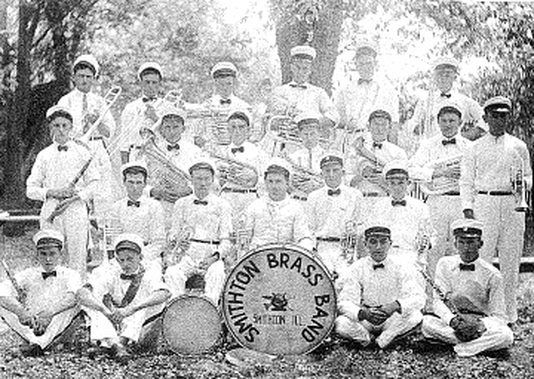
SMITHTON BRASS BAND (photo taken' at Smithton Turner Picnic 1915). First row (Turner): John Schaefer, Wm. Miller (future Turner), Henry Bauer, John Phillips (Turner). Second Row (Turner) Philip Lannert, Charles Schanz (Turner), Charles Hill Band Leader, Walter B. Phillips (Turner), Edmund Schanz (future Turner).
Third Row (1 to r) Carl Hausman (future Turner), Philip Lindauer (Turner), Dewey Schanz, George Bernius, Arthur Stock (Turner), Edwin Lindauer (Turrner), Gus Stafest. Fourth Row (l to r) George
Hoelscher, Claus Daesch, Adolph Schanz (future Turner), Frank Wenzel, Wm. Riedel (future Turner), Armin Daab (future Turner).
The trousers worn by the band were made by the late "Fannie' Schanz, a member of the Ladies Turner Society. The writer still has the band cap worn in the picture
in his possession.The Smithton Brass Band, consisting largely of Turner members, was formed in 1913 through the efforts of Turner Charles Schanz and Band Leader Charles Hill of Hecker, illinois. The band participated in the Belleville Centennial Parade in 1914 and is shown in the photograph next page, right of picture, wearing white uniforms. This photograph was taken on North Illinois Street and Market Square. The band preceded the Smithton Log Cabin float in that parade. Most of the band members and their instruments were transported from Smithton to Belleville over the "Old Plank Road" by a team and hay wagon owned by Turner August Poetker.
Third Row (1 to r) Carl Hausman (future Turner), Philip Lindauer (Turner), Dewey Schanz, George Bernius, Arthur Stock (Turner), Edwin Lindauer (Turrner), Gus Stafest. Fourth Row (l to r) George
Hoelscher, Claus Daesch, Adolph Schanz (future Turner), Frank Wenzel, Wm. Riedel (future Turner), Armin Daab (future Turner).
The trousers worn by the band were made by the late "Fannie' Schanz, a member of the Ladies Turner Society. The writer still has the band cap worn in the picture
in his possession.The Smithton Brass Band, consisting largely of Turner members, was formed in 1913 through the efforts of Turner Charles Schanz and Band Leader Charles Hill of Hecker, illinois. The band participated in the Belleville Centennial Parade in 1914 and is shown in the photograph next page, right of picture, wearing white uniforms. This photograph was taken on North Illinois Street and Market Square. The band preceded the Smithton Log Cabin float in that parade. Most of the band members and their instruments were transported from Smithton to Belleville over the "Old Plank Road" by a team and hay wagon owned by Turner August Poetker.
